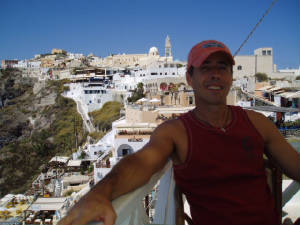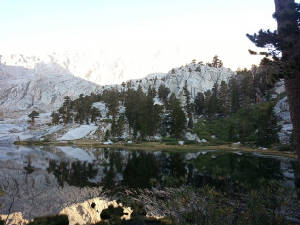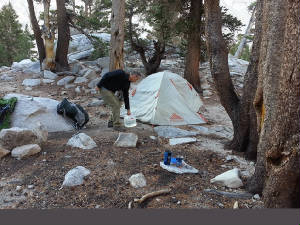The hot water wouldn’t boil. I checked the flame again, and it was blue and
strong, and there didn’t appear to be anything wrong with the fast-boil mini camp stove, as my numb fingers fumbled
with it, outside the leeward side of the SUV. We were baffled, but realized it was probably due to the altitude. We camped
at nearly 11,000 feet elevation, and the temperature was freezing despite the fact it was the morning of September 14, 2014
in California. Eventually the water boiled and Barry added the hot chocolate mix so we could thaw out from a cold sleepless
night before our climb. Hot apple cinnamon oatmeal was next on the breakfast menu.
We spent the prior day driving up mountain roads from the floor of the Owens Valley, toward White Mountain Peak,
the 3rd highest mountain in California at 14,252 feet elevation. We
were enamored and enchanted by the rugged beauty of the bristlecone pine trees as we reached the tree line area at 10,000
feet. Their gnarled ruddy trucks twisted upward and presented a fine contrast with their arbor green leaves against the blue
sky and puffy white clouds. You could almost feel the wood crackle as you surveyed the deep grooves in the bark and twists,
evident from their resistance for millennia to the harsh cold windy dry conditions that made them strong. At 3,000 to 5,000
years of age, they are the oldest living things on earth.
It was
dark as we donned our insulated clothing and down coats and headlamps, locked the truck doors, and pressed into the waning
hours of the night. The stars regaled us with crisp cold constellations as the ground crunched beneath our hiking boots. We
had a 13-mile arduous journey ahead of us, but excitement lightened our steps as the sun peeked lazily over the horizon. The
rising sun revealed a stark tundra-like landscape, an environment tortured by years of a brutally cold, arid assault from
Mother Nature. For a moment, I imagined I was in Antarctica.
Higher
and higher we climbed, and the wind blew harder, and the air grew thinner. We pulled our hoods over our heads, but bites of
icy air nipped at the exposed skin on our faces and our hands, left uncovered. Our gloves were warm and safe at home, happy
we forgot them. Brigades of rocks and hoards of switchbacks tormented us. An ordinary task of eating a snack bar and drinking
some juice required a deliberate effort. Sipping water from our backpack tubes was the only chore that came easy, and frequently.
Upward
and onward, White Mountain Peak appeared and disappeared, teasing us forward. We were close now, but it was agonizing to climb
in its shadow, not really knowing how far. Each step was grueling and exhausting. Breathing was a chore, gasping for oxygen,
as arctic-like gales seared our lungs. Finally, the last switchback was conquered, and the summit was ours. Grimace turned
to smile, and then to awe, as the Sierra Nevada Mountain Range in all its majesty rose in the distance. We were speechless.
The view was spectacular, and the journey was worth it. We were now higher than all but two of the hundreds of pinnacles towering
before us. Mount Whitney was already in our bucket, but Mount Williamson grinned at us from afar.



